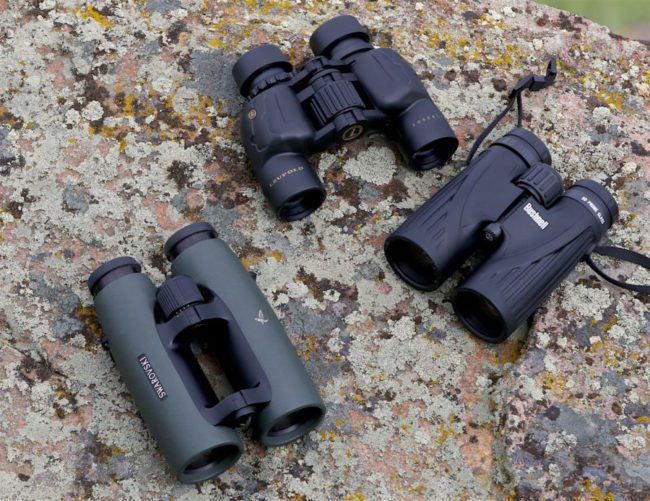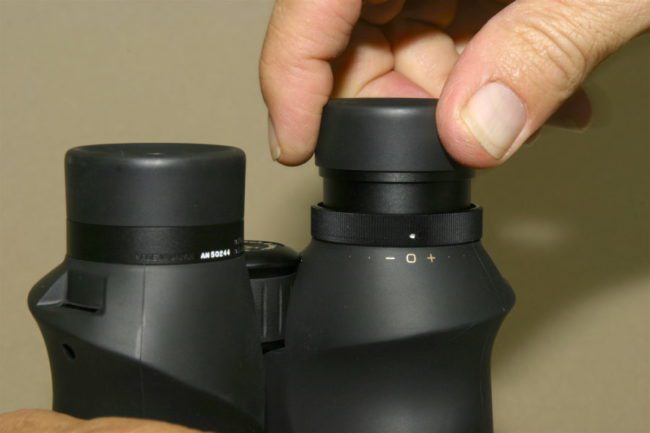Making your low-cost plains-game hunt without a safari binocular is like hiking the Pacific Crest Trail without boots. It can be done, but it won’t be as much fun. To maximize safari fun, take along your best safari binocular.
Here’s how to find it:
WHY A BEST SAFARI BINOCULAR?
Few of us would dream of hunting big game with the naked eye only these days, but I’ve heard hunters recommend doing just that on safari.
“Your PH will tell you what to shoot.”
True, but he won’t describe the gorgeous colors of a lilac-breasted roller, the toothy smile of a crocodile, or the sparkle in the massive eye of a diminutive dik-dik peeking from the brush. Forget your binocular and you’ll miss 80 percent of your visual adventure. In a new and exotic land like Namibia or South Africa, you’ll want bright, crisp, enlarged views of everything. Each day is a joyful discovery, and an 8X safari binocular makes it eight times better.
The binocular you use for deer or elk hunting in the States can suffice in Africa, but if it’s marginal, you should upgrade. I don’t think it’s necessary or even wise to upgrade your rifle for a safari, but a better binocular? That’s a wise, lifetime investment. Optical quality really matters when you’re trying to distinguish a patch of hair and curl of dark horn through the brush.
You don’t have to spend $2,000, $1,000, or even $500 to get a sharp, bright, effective binocular, but the less you spend, the more important it is to understand what makes a binocular good, bad, or horrible. That way you can use your limited funds to purchase the most important ingredients.
But I urge you to stretch as much as you can on this purchase. Don’t be that guy who wastes $60 on one bad unit, then $120 on another, and on up the scale before finding an instrument you will love and use for a lifetime.

The Porro prism Leupold Yosemite on top is a great example of an inexpensive yet bright, sharp, functional binocular. The Swarovski EL roof prism 8.5×42 is the kind of one-and-done expensive optic you’ll cherish for a lifetime. The Bushnell Legend Ultra HD roof prism with ED glass is one of today’s typical, budget-priced roof prisms that is amazingly good for well under $500. Figure to spend 1.5X to 2.5X more on a roof prism to match the optical quality in a Porro.
PORRO PRISM VS. ROOF PRISM IN BEST SAFARI BINOCULAR
Porro prisms, like Leupold’s BX-1 Yosemite, Bushnell’s Legacy WP, Alpen’s Shasta Ridge, and Nikon’s Action EX models are binoculars with those old-fashioned, stepped barrels with the objective lenses set farther apart than the eyepiece lenses. While not as sleek and compact as modern, straight-barrel roof prisms, Porros can be sharper and brighter for about 1/3 to ½ the cost.
They can also accommodate especially narrow- or wide-set eyes. The Porro prisms do not require mirrors, BaK-4 glass, or Phase coatings like roof prisms do, but they can more easily be bumped out of alignment. For $80 to $200, you should get a bright, sharp view through a Porro prism binocular. Take reasonable care of it and it should serve you well for two or three decades.
Roof prisms are more compact than Porros but, like some pizzas, require “better ingredients” for equal optical performance. Figure to spend $200 and up for a decent roof prism. Cough up about $350 to $500 and you’re getting so close to the optical performance of a $1,000 unit that you might not be able to detect the difference. A top-line model like the Swarovski EL can run $1,800 to nearly $4,000. If you can afford it, duh! Buy it. You’ll have the best with no need to upgrade later.
But if you can’t find $2,000 between the sofa cushions, check out some of the new $300 to $500 roof models. Many, like Leupold’s new BX-3 Mojave and Bushnell’s Legend Ultra HD, are impressively bright and sharp at that price. I’ve been impressed by the view through several Alpens and recently a new Styrka S7. The truth is today’s binocular market is awash in new brands and models, many of which are so close in quality that it’s hard to pick a winner. The upside is that prices have tumbled thanks to all the competition. It’s a buyer’s market and a great time to buy a high-quality binocular.
Whatever you spend for a roof-prism instrument, insist on phase-coated, BaK-4 prism glass and fully multicoated lenses for maximum brightness. Those multiple layers of anti-reflection coatings on every air-to-glass surface are what really increase brightness. You’ll need anti-reflections in Porro units, too.
Some roof-prism designs use a mirror on one surface, and the quality of this mirror impacts light transmission through the unit. Silver makes for an excellent mirror, but a dielectric mirror is slightly better. Just don’t settle for an aluminum mirror.

Rubber-coated, twist-up eyecups are useful. Note the ring-style diopter-adjustment wheel around the right eyepiece barrel. Set it once and you probably won’t need to adjust it for a decade or more. It should be inconspicuous and hard to move.
BEST SAFARI BINOCULAR POWER OPTIONS
Don’t go overboard with magnification. More power means enhanced shake, less field of view, and less depth of focus. Few users can handle more than 10X. I prefer 6X in brush and woods, but in the open deserts common in much of southern Africa, 10X is useful. Just be aware you’ll feel a bit cramped in brush and thickets due to the narrower field of view at 10X. My all-round choice is 8X, the .30-06 of binocular powers.
Lower power means a brighter view, too, thanks to bigger Exit Pupils. These are the tiny circles of light you can see in the eyepieces. Hold any binocular about 18 inches from your eyes, pointed at a bright surface. The little white circles in the eyepieces are the “keyholes” you must look through. All the light from the reflected image streams through them. They should be four to five millimeters wide for effective brightness through legal hunting hours.
Here’s a simple way to measure EP diameter: Divide the objective-lens diameter in millimeters by the power, and the answer will be the EP diameter in millimeters. A 10x42mm binocular yields a 4.2mm EP. An 8×42 makes a 5.25mm EP, and an 8x32mm has a 4mm EP. The difference is due to the size of the objective lenses and the power. The larger the objectives, the more light that gets in. The higher the magnification, the less light that gets out (smaller EP). Always divide objective-lens diameter by power to get diameter of EP.
Note: Learn more about binoculars in this YouTube video from Ron Spomer, and check back tomorrow for the conclusion of this informative article.
For more from Ron Spomer, check out his website, ronspomeroutdoors.com, and be sure to subscribe to Sporting Classics for his rifles column and features.

